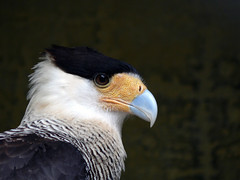The world is a mask that hides the real world.
Thatâs what everybody suspects, though the world we see wonât let us dwell on it long.
The world has ways - more masks - of getting our attention.
The suspicion sneaks in now and again, between the cracks of everyday existenceâ¦the bird song dips, rises, dips, trails off into blue sky silence before the note that would reveal the shape of a melody that, somehow, would tie everything together, on the verge of unmasking the hidden armature that frames this sky, this tree, this bird, this quivering green leaf, jewels in a crown.â¦
As the song dies, the secret withdraws.
The tree is a mask.
The sky is a mask.
The quivering green leaf is a mask.
The song is a mask.
The singing bird is a mask.
Friday, December 02, 2005
wild parrot man: once homeless, now an author with a movie in theaters everywhere
The Guardian, Friday December 2, 2005
No one knows how a flock of Peruvian parrots made it to San Francisco. But one thing seems certain: they're about to become international stars.
The view from the top of Telegraph Hill is breathtaking: fog rolling in across the Golden Gate bridge, ferries chugging across the bay to Alcatraz. The parrots like it, too. Scattered across the cypress trees, their bright green feathers and red faces vivid against the khaki leaves, they stare out across the water, just like the tourists - except now the parrots are tourist attractions themselves.
In matters of real estate, Peruvian wild parrots have taste. Telegraph Hill, in the sunny north-east of San Francisco, is a dense neighbourhood of steep, narrow streets - implausibly steep pavements are forced to morph into staircases, when they don't give up and revert to being cliffs - with wild, jungly gardens and little houses that cost the earth. It climbs through North Beach - San Francisco's great bohemian neighbourhood of strip joints, jazz clubs and beatnik cafes - ending 540ft up on Coit Tower, the priapic monument modelled on a hose-nozzle, erected by a millionairess with a thing for firemen.
For the longest time, only locals knew about these avian lodgers - all cherry-headed conures except one. But since the release last year of Judy Irving's successful documentary film The Wild Parrots of Telegraph Hill and Mark Bittner's book of the same name, the parrots have become national stars. Soon to be international, judging by overseas interest. When the next Time Out guide is published, there'll probably be parrot-spotting walks alongside the entries on Coit Tower, City Lights bookshop and Caffe Trieste.
Quite how the parrots got from Peru to North Beach, no one knows, though the movie offers plenty of theories: lorries crashing en route to pet shops; parrots hitching rides on container ships. But it's a tolerant place, San Francisco - as America goes, remarkably tolerant - so a flock of exotic birds sharing a few city blocks with the native sparrows and pigeons is as unremarkable as a street with Chinatown down one end and Little Italy down the other.
Tolerance, in fact, is one of the movie's underlying themes - along with freedom, connecting, materialism, ecology, Zen, and love. Which makes it a gentler, more bittersweet avian blockbuster than March of the Penguins, and very San Franciscan.
Irving has specialised in environmental films (Dark Circle, about the nuclear power industry, won a Sundance festival award) but this was her first "portrait film", the story of Bittner, an enigmatic, endearing, fiftysomething - homeless, jobless, but contented and self-sustaining - and his remarkably close relationship with the parrots. Irving, a cockatiel owner - it's perched on her knee as we talk - saw an article he wrote about it in Bird Talk magazine and immediately thought of a film. But the article said he'd had to leave the hill. When she heard he'd moved back, she contacted him. Keen to have a "visual memory" before he was forced to leave again, he gave her the go-ahead.
What started out for Irving as "sort of a hobby, with four rolls of 16mm film I had left over from another shoot" grew over four-and-a-half years from a 20 minute short to "this thing that changed my life". It would spoil the ending of the film to say precisely how.
After we've come to know and recognise Connor, the blue-headed parrot loner, Mingus, who nods like a junked-out jazzman whenever Bittner plays guitar, the hoodlum Sonny, coquettish Sophie and her big mate Picasso; after we've seen Bittner tend the sick and injured parrots and heard insights into their behaviour learned from spending hour upon hour sitting among them with a bowl of sunflower seeds, like a Buddhist Saint Francis, it's a shock when the camera cuts to an old homeless woman feeding pigeons on the streets. Irving asks Bittner what makes him different from the bag lady. He has no answer.
Asked the same question now, he says: "Really, the only difference is a lot of homeless people have drug and alcohol problems and I didn't." Bittner says he became homeless "by accident" in the 1970s when he moved from Seattle to become a musician and was disillusioned by an untrustworthy manager, his own egotism, and the break-up of a love affair. Since "it had all come apart at the seams", he decided to be a "seeker", as people did back then; he read a lot, crashed with friends, slept outdoors and relied on the kindness of strangers.
"I didn't work very much, but all I really needed was to feed myself and wash my clothes. Seeds are not that expensive." When vet bills for the birds needed paying, he'd pin a notice on the grocery shop wall and within hours get a call telling him a well-wisher had left a $100 bill.
Bittner says he was reading a book by San Franciscan beat/nature poet Gary Snyder when he first noticed the parrots. By another accident, for the next few years they became his full-time job. "I loved them, cared for them, just became absorbed with them, and in the end they brought me everything." He and his new partner have just bought a cottage on Telegraph Hill, where he is writing his second book - not about parrots. "I didn't see myself as the Parrot Man for life."
But he and Irving are still watching out for them. The film and book have become a focus for a campaign against a Connecticut utility company trying to gas a wild parrot flock. And, closer to home, they're meeting this week with a neighbour who has chopped down three of the five cypress trees on Telegraph Hill that the parrots call home. Such is the flock's fame that wire services and national newspapers are vying over which will be first to get the results. Bittner is hoping that the new DVD release will keep the wild birds a priority. "We want to celebrate wildness," he says, "not destroy it."
· The Wild Parrots of Telegraph Hill is released on December 9.
distributed memory, but not a "hard disk"
Memory formation follows a dynamic pattern, allowing for retrieval from different areas of the brain, depending on when an organism needs to remember, said a researcher at Baylor College of Medicine.
That is what Dr. Ron L. Davis, professor of molecular and cellular biology at BCM, theorizes, based on his most recent report on the topic that finds a memory trace in Drosophila or fruit flies is formed in a pair of neurons called the dorsal pair medial neurons, but only 30 minutes after the fact and only through the mediation of a gene called, ironically, amnesiac. (A memory trace is a chemical change in tissue that represents the formation of a memory.) The study appears in the current issue of the journal Cell.
Davis and his colleagues were one of the first to actually record a memory trace being formed. That one was first stored in the insect's antennal lobe (where odors are processed). The flies are trained to associate an odor with an electric shock. The change in these neurons was immediate, but lasted only five to seven minutes.
In the more recent report involving the DPM neurons, the change can be seen 30 minutes after the formation of the memory, but it lasts about two hours.
"The other intriguing thing we don't understand is that this occurs only in one branch of the DPM neuron," said Davis. "Our impression now is that maybe what guides the behavior after training in the first few minutes is the antennal lobe. That is the important part that guides behavior for the small window of time after training. The DPM neurons have that role from 30 minutes to two hours."
The finding belies the commonly held precept that a memory is formed in the same way that data are stored in a computer – always in the same place.
"It's not as if we are forming memories that are then being written to a "hard disk" area of the brain, and it's there and recalled from the same location at any time after learning," said Davis. "We now think that different areas of the brain have dominion over small intervals of time after training. One area might have dominion and then another." Others who participated in the research include Drs. Dinghui Yu and Anjana Srivatsan, both of BCM, and Scott Waddell and graduate student Alex Keene, of the University of Massachusetts Medical Center.
EurekAlert! Public release date: 2-Dec-2005
Contact: Ross Tomlin
htomlin@bcm.tmc.edu
713-798-4712
Baylor College of Medicine
Funding for this study came from the National Institutes of Health, the Mathers Charitable Trust, the R.P. Doherty-Welch Chair in Science and the Edward Mallinckrodt, Jr., Foundation.

This image is easy to remember, no matter
how memory might accomplish that.
walking mermaid
Thursday, December 01, 2005
hunger-crazed squirrels said to kill, gut & eat stray dog
Squirrels have bitten to death a stray dog which was barking at them in a Russian park, local media report.
Passers-by were reportedly too late to stop the attack by the black squirrels in a village in the far east, which reportedly lasted about a minute.
They are said to have scampered off at the sight of humans, some carrying pieces of flesh.
A pine cone shortage may have led the squirrels to seek other food sources, although scientists are sceptical.
The attack was reported in parkland in the centre of Lazo, a village in the Maritime Territory, and was witnessed by three local people.
A "big" stray dog was nosing about the trees and barking at squirrels hiding in branches overhead when a number of them suddenly descended and attacked, reports say.
"They literally gutted the dog," local journalist Anastasia Trubitsina told Komsomolskaya Pravda newspaper.
"When they saw the men, they scattered in different directions, taking pieces of their kill away with them."
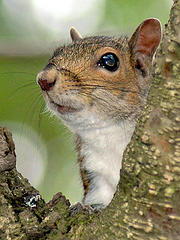
This proud and noble beast is not known to have participated in the attack.
Mikhail Tiyunov, a scientist in the region, said it was the first he had ever heard of such an attack.
While squirrels without sources of protein might attack birds' nests, he said, the idea of them chewing at a dog to death was "absurd".
"If it really happened, things must be pretty bad in our forests," he added.
Komosmolskaya Pravda notes that in a previous incident this autumn chipmunks terrorised cats in a part of the territory.
A Lazo man who called himself only Mikhalich said there had been "no pine cones at all" in the local forests this year.
"The little beasts are agitated because they have nothing to eat," he said.
Story from BBC NEWS:
http://news.bbc.co.uk/go/pr/fr/-/2/hi/europe/4489792.stm
Published: 2005/12/01 18:14:15 GMT
© BBC MMV
line blurs between early dinosaurs & birds
19:00 01 December 2005
NewScientist.com news service
by Jeff Hecht
The oldest known bird was closer to a dinosaur than previously thought – a discovery that confuses the evolutionary tree as we currently understand it.
An exceptionally well preserved new fossil reveals a foot and skull that more closely resemble those of a group of two-legged predatory dinosaurs called the known as dromeosaurs, than modern birds.
With jagged teeth and a dinosaur-like skeleton, the archaeopteryx is unlike any modern species of bird. But flight feathers on its long front limbs have led palaeontologists to identify the creature as the oldest known species of bird.
Nine previously known specimens of archaeopteryx have led palaeontologists to conclude that birds probably evolved from small meat-eating dinosaurs, and are closely related to the dromeosaurs, a group that includes the velociraptor. Yet precisely how archaeopteryx is related to the raptors has remained unclear – key pieces of these previous specimens are missing.
But the newly revealed fossil appears to fill in many of the gaps. The specimen comes from the private collection of a worker at the Solnhofen limestone quarries in Germany, where the first archaeopteryx fossil was discovered. It has remained unknown to science until its owner's death, when the new owner made it available to scientists at the Wyoming Dinosaur Center in the US.

With jagged teeth and raptor-like features, the feathered archaeopteryx is unlike any modern species of bird (Image: G Mayr/Senckenberg)
Computer model
A complete foot reveals that archaeopteryx had an extensible claw on its second toe, which is a hallmark of raptors, but is absent in all known birds. Its first toe, or "hallux", is also at the side of the foot and not reversed as it is in perching birds, which use it to grasp branches.
The skull is also well preserved and shows that the animal had a skull bone known as the "palatine", which is shaped in the same way as in many two-legged dinosaurs.
The new traits were added to a computer model, enabling palaeontologists to analyse the relationship between extinct species. "It's now very difficult to distinguish between [early] birds and [early] dromeosaurs," says Gerald Mayr of the Senckenberg Research Institute in Frankfurt, Germany, who studied the specimen.
Question of class
Mayr told New Scientist that there are no unique traits shared by archaeopteryx and other early bird-like fossils that are not present in dinosaurs. This would either mean that archaeopteryx cannot be classed within the same evolutionary group as birds or that this group needs to be redefined.
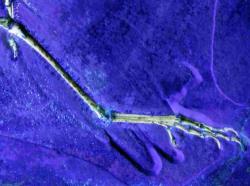
Ultraviolet light enhances details of a complete foot, showing that archaeopteryx had an extensible claw on its second toe – a hallmark of raptors – which is absent in all known birds (Image: G Mayr/Senckenberg)
But Peter Makovicky of the Field Museum of Natural History in Chicago, US, says those results are shaky because Mayr's group considered only three bird-like creatures; archaeopteryx, confuciusornis and a primitive bird called Rahonavis, that lived much later.
In October 2005, Makovicky carried out a separate study that links Rahonavis directly to the dromeosaurs and suggests this species may have evolved flight separately from archaeopteryx and other birds. Makovicky told New Scientist he found no change in the shape of his evolutionary tree when he added the new traits found for archaeopteryx.
Journal reference: Science (Vol 310, p 1483)
Related Articles
Raptor inflicted death by a thousand bites
http://www.newscientist.com/article.ns?id=mg18825224.600
22 October 2005
Can 'feather foot' knock oldest bird off its perch?
http://www.newscientist.com/article.ns?id=mg18524874.700
19 February 2005
Flying dinosaur needed a bird's brain
http://www.newscientist.com/article.ns?id=dn6244
04 August 2004
Weblinks
Science
http://www.sciencemag.org/
Field Museum of Natural History
http://www.fieldmuseum.org/
Senckenberg Research Institute
http://www.senckenberg.de/
scary, ancient human-sized water scorpion only ate fleas
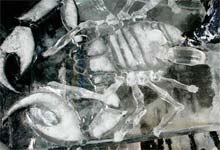 Times of London:
Times of London:The footprints of one of the most fearsome creatures ever found in the British Isles — a water scorpion the length of a person — have been discovered in Scotland.
Tracks in rock on the east coast of Scotland were created 330 million years ago by the six-legged Hibbertopterus, which was 1.6m (5ft 3in) long and 1m (3ft 3in) wide. The water scorpion, which is distantly related to its small modern cousins, had two claw-like arms, an armoured exoskeleton and a powerful tail tipped with a large, flat spike — although it was not poisonous.
“I think it would have been a pretty fearsome sight,” said Martin Whyte, of the University of Sheffield, a geologist who found the tracks. Despite its formidable appearance, the creature would have presented little threat to people. It fed on smaller prey such as water fleas and as an aquatic animal would have been easy to outrun on land. The discovery, published today in the journal Nature, is the first of its kind in the world.
[photo: Associated Press]
lament for the Maltese falcon
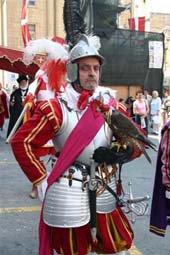
Wildlife conservation in Europe: Lament for the Maltese Falcon
Every year, around two million wild birds are massacred on Malta as they migrate from Europe to their winter quarters in Africa. Some species, such as the peregrine falcon, have now disappeared from the island altogether. The European Union has the hunters in its sights, but as Anne Penketh reports from Valletta, they are proving an elusive - and defiant - quarry
At the entrance to the Buskett bird sanctuary in Malta, a notice warns visitors that "no hunting or trapping is allowed within the nature reserve" and gives them a telephone number to report violations. Less than 200 yards away lies a red spent cartridge, proof that Maltese hunters are prepared to risk being reported to the police by shooting their prey in one of the island's few protected zones.
Hunting birds has been part of Maltese life for hundreds, if not thousands of years. "Go to the port, how many seagulls do you see? None - that's because they shot them all," says a shopkeeper in the capital, Valletta.
He is not joking. Every year, according to the bird protection society BirdLife Malta, up to two million birds are massacred on Malta, which lies in the very centre of the migratory route between Europe and Africa. Other estimates put the death toll much higher. There are 12,500 registered hunters and 4,300 trappers on an island with a population of 400,000 crammed onto its rocky outcrops. They trap finches for breeding and sale, and shoot anything that flies, from birds of prey to quail and skylarks. Some, like thrushes and turtle doves, end up on the dinner table, others are kept caged on rooftops, but most are stuffed as trophies and displayed in cabinets by the hunters for bragging rights. In Malta, they shoot swallows for target practice.
But now the European Union has the hunters in its sights. Since Malta joined the EU last year, it is supposed to have implemented the EU's Birds Directive, which protects birds and their habitats throughout Europe, and regulates bird hunting. It notably bans trapping, and forbids the hunting of birds on their way to breed and during the breeding season.
But the country's hunting lobby is powerful. In an attempt to keep the hunters' vote in the run-up to Malta's referendum on EU membership, the government promised it would preserve turtle dove and quail hunting in spring - the height of the shooting season, when hundreds of thousands of birds return to Italy and the Balkans from Africa.
Malta has one of the shortest close seasons in Europe, from 22 May to 31 August, but even that is rarely observed. It was only in 1980 that the government enacted laws to control hunting, and set up the protected zones. But for many years they were ignored by the hunters, and not enforced by police.
The president of BirdLife Malta, Joseph Mangion, says the situation in the reserves has improved over the past five years, but elsewhere illegal hunting is rife. The shooters, who have resorted to vandalism and violence in the past to protest against hunting restrictions, "are not so blatant about it, they no longer put up hunting hides in the park". But he says that "smash-and-grab raids" are still taking place. "This past week, we had regular reports of illegal hunters in Buskett. There's been a good migration of woodcock, that's why they're trying their luck."
On the windswept, barren scrubland of the Dingli cliffs, just south of the park, the landscape is dotted with stone-built hides that stand among the cacti. Finch-trapping is another popular activity - nets are dropped on the birds, sometimes catching entire flocks. Maltese trappers who were setting out their cages last Saturday afternoon said they were waiting for greenfinches. One, dressed in army fatigues, already had a boot-load caged in his car, covered with a sheet and twittering faintly.
The sale of birds is now only permitted if they have been bred or legally imported. Illegal tradesmen have moved their market stalls from Valletta to Mdina, Malta's ancient capital further inland, in hopes of escaping the attention of the police. But they carry out successful raids from time to time. Such is the Maltese obsession with birds that some of the breeders experiment with cross-breeds, in the hope of producing the perfect birdsong.
They cross linnets, greenfinches, canaries and goldfinches, resulting in much-prized, but sterile, birds known as baghal (mule). To strengthen their song, they have to be kept with the species that the breeder or trapper wants them to imitate - otherwise, they mimic the wrong songs and become worthless.
Mr Mangion is furious about the government's foot-dragging in implementing the EU directive, and says that it cannot impose a derogation until that is done. "Our main issues are: firstly, get the directive transposed into law and implemented, which means no spring hunting and trapping. Hunting in spring is just a 'no go' for us. The deaths are too high. Hunters know they have to change their ways.
"Second, we need law enforcement and increased resources. Unless we have a good police presence, hunters won't change their behaviour."
The protected zones are currently monitored by an arm of the police, the Administration Law Enforcement section, which monitors the environment and has raised awareness of illegal hunting. But according to locals, some police are also hunters.
The hunters know they are under pressure: on Saturday they were very much on the defensive. One, wearing a woolly jumper, emerged from a hide to wave his arms aggressively and say repeatedly, "I see nothing", while another volunteered the information that he was trapping the birds for breeding before any questions had been asked.
At first glance the hunting debate seems to reflect a generational conflict in Malta, with young and urban professionals joining the Alternattiva Demokratika green party and BirdLife Malta, which now has 3,000 members under the presidency of Mr Mangion, who is a fire and security surveyor for an insurance company.
But the Maltese say that is a false impression. In fact, many young people are joining the huntsmen, buying a licence at the legal age of 18. According to Maltese experts, the damage done to the hunting culture in the past was by people who did not come from hunting families, and would fire at anything that moved. Those were the days when marsh harriers would go straight into a casserole, and when the stuffed heads of protected species would be proudly displayed by drivers on their rear-view mirrors.
Because of EU membership, the two sides in the bird war have been forced to meet. But it was not always so: in the past relations were violent, with hunters carrying out vicious protests. They have poured oil into wetlands, and punched an environment minister who then had to take on police protection.
The hunters are represented by an association now called the Federation for Hunting and Conservation. They maintain that Maltese shooters and trappers form an important part of the economic, social, cultural and political life of Malta and Gozo, "and any sportsman thus expects to exercise his legal right to practise hunting and trapping in the traditional manner, so long as he is fully aware that his harvesting does not constitute any threat to any particular species".
The association's president, Lino Farrugia, rejects what he calls the "no use" approach favoured by the "protectionists", and says the hunters stand for a "wise use" of natural resources.
The association is also concerned about precautionary measures introduced by the government to protect against bird flu, pointing out that there is no direct evidence that it is caused by bird migration. The hunters are notably fighting a temporary government ban on live decoys of golden plovers in the wetlands, aimed at preventing the spread of bird flu. (One of the jokes doing the rounds in Valletta contends that thanks to bird flu, for the first time nobody minds the hunters shooting.)
Malta's bird-hunting traditions have meant that entire species, such as kestrel, jackdaw, barn owl and peregrine falcon, have been wiped out. Only a dozen resident species remain, including the Spanish sparrow, but none are birds of prey. Even rabbits have been hunted almost to extinction: the rabbit stew on the menu in local restaurants is certain to have been bred.
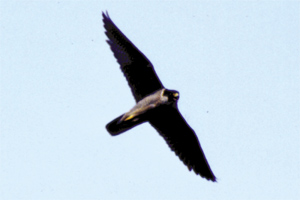
Maltese falcon
Natalino Fenech described the history of Maltese hunting in a 1992 book, Fatal Flight: The Maltese Obsession with Killing Birds, which chronicled the annual death toll of three million finches, more than half a million thrushes, 500,000 swallows, 80,000 golden orioles, 18,000 shearwaters and 50,000 birds of prey.
Malta has destroyed its own heritage: when the island was ceded by Charles V to the Knights of St John in 1530, it was on condition that an annual rent of two Maltese falcons was paid - one to the Spanish emperor and the other to the viceroy of Sicily. Maltese falcons were reputed to be the finest of the peregrines. By the 1970s, the species had been all but destroyed by hunting. The last pair was shot off Ta' Cenc cliffs in 1980.
It may have been no accident that the bird in Dashiell Hammett's classic detective novel, The Maltese Falcon, is not a real falcon, but a statue. But in the ultimate irony, Malta's national bird, the blue rock thrush, still features on its one-lira coin.
250-million-years-ago gas-powered mass extinction predicts next one?
The world's largest mass extinction was probably caused by poisonous volcanic gas, according to research published today.
The research, published in the journal Geology, reveals vital clues about the mass extinction at the end of the Permian period, 250 million years ago, when mammal-like reptiles known as synapsids roamed the earth.
Many scientists had previously thought that an asteroid hitting the earth or a deep-sea methane release had caused the extinction, which obliterated more than two-thirds of reptile and amphibian families.
However, analysis of a unique set of molecules found in rocks taken from the Dolomites in Italy has enabled scientists to build up a picture of what actually happened. The molecules are the remains of polysaccharides, large sugar-based structures common in plants and soil, and they tell the story of the extinction.
The molecules date from the same time as a major volcanic eruption that caused the greatest ever outpouring of basalt lava over vast swathes of land in present day Siberia.
The researchers believe that the volcanic gases from the eruption, which would have depleted earth's protective ozone layer and acidified the land and sea, killed rooted vegetation. This meant that soil was no longer retained and it washed into the surrounding oceans.
The chemistry of the rocks reveals that although the sugar molecules were found in marine sediments, they derived from land, supporting the theory that massive soil erosion caused them to end up in the sea.
Soil materials in the oceans would have blocked out light and soaked up oxygen. Analysis of rock chemistry suggests that after the soil crisis on land, the marine ecosystem succumbed to the stresses of environmental change and oceanic life faltered, completing a global catastrophe.
Dr Mark Sephton, from Imperial College London's Department of Earth Sciences and Engineering and lead author of the research, said: "The cause of the end Permian extinction has been highly controversial. We show that the terrestrial ecosystem was the first to suffer. The continent-wide nature of the event implies that it was caused by something in the atmosphere. The unique chemical data indicates that something fast and catastrophic happened on land."
Prof Henk Visscher of Utrecht University, also part of the research team, commented: "Similar to the 'Dead Zone' nowadays spreading in the Gulf of Mexico, the soil crisis could have caused a worldwide expanse of uninhabitable low-oxygen conditions in shallow marine waters. So what began on land ended in the sea. It seems there was no place to hide at this time of great dying."
Dr Sephton believes that lessons can be learned in the present day from the damage caused by the end Permian extinction: "Land degradation is a worsening global problem thanks to human activity and soil erosion has caused the loss of a third of arable land over the last forty years. 35% of the Earth's land is now soil-free. Identifying the nature of the end Permian soil crisis may help us understand what is in store for us in the years ahead," he said.
The research was carried out by an international team of scientists from the United Kingdom, the Netherlands and the United States.
Contact: Laura Gallagher
l.gallagher@imperial.ac.uk
44-020-7594-6702
Imperial College London
EurekAlert! Public release date: 1-Dec-2005
Wednesday, November 30, 2005
mouse brain online
UPTON, NY -- Researchers at the U.S. Department of Energy's Brookhaven National Laboratory have just launched a web-based 3-D digital atlas browser and database of the brain of a popular laboratory mouse (see http://www.bnl.gov/CTN/mouse/).
"Neuroscientists around the world can now download these extremely accurate anatomical templates and use them to map other data -- such as which parts of the brain are metabolically active and where particular genes are expressed -- and for making quantitative anatomical comparisons with other, genetically engineered mouse strains," said project leader Helene Benveniste, who is a researcher in Brookhaven's medical department and a professor of anesthesiology at Stony Brook University.

The database was created using high-resolution magnetic resonance (MR) microscopy at the University of Florida in collaboration with researchers from Brookhaven Lab's Center for Translational Neuroimaging. The work was done in parallel with an international collaboration, the Mouse Phenome Database (MPD) project, which was created to establish a collection of baseline phenotypic data from commonly used inbred mice.
The new brain atlas database consists of 3-D anatomical data from 10 adult male mice of the strain C57BL/6J, and contains data on 20 segmented structures, including variability of brain structures across the strain, and downloadable visualization tools.
The research that makes up this database was published as a cover article in the October 2005 issue of the journal Neuroscience.
###
This research was initially funded by the National Institute on Drug Abuse and then by the National Institute of Biomedical Imaging and Bioengineering (NIBIB). The development of the web-browser and database was supported by both NIBIB and the Office of Biological and Environmental Research within the U.S. Department of Energy's Office of Science. A variety of brain-imaging techniques including magnetic resonance imaging are a direct outgrowth of DOE's support of basic physics research.
One of the ten national laboratories overseen and primarily funded by the Office of Science of the U.S. Department of Energy (DOE), Brookhaven National Laboratory conducts research in the physical, biomedical, and environmental sciences, as well as in energy technologies and national security. Brookhaven Lab also builds and operates major scientific facilities available to university, industry and government researchers. Brookhaven is operated and managed for DOE's Office of Science by Brookhaven Science Associates, a limited-liability company founded by Stony Brook University, the largest academic user of Laboratory facilities, and Battelle, a nonprofit, applied science and technology organization. Visit Brookhaven Lab's electronic newsroom for links, news archives, graphics, and more: http://www.bnl.gov/newsroom
EurekAlert! Public release date: 30-Nov-2005
Contact: Karen McNulty Walsh
kmcnulty@bnl.gov
631-344-8350
DOE/Brookhaven National Laboratory
Monday, November 28, 2005
researchers prove bees can fly
by Helen Phillips 28 November 2005, NewScientist.com news service
Combining robotic modelling with slow-motion videos of airborne honeybees may have helped researchers explain the curious aerodynamics of bee flight.
Aeronautical engineers had previously “proven” that bees cannot fly. So Michael Dickinson, an insect flight expert and colleagues at Caltech in Pasadena, California, US, decided to investigate the forces actually at work during honeybee flight.
In 1996, Charlie Ellington at Cambridge University, UK, showed how vortices rolling along the leading edge of many insects’ wings were a vital source of lift.
Most flying insects beat their wings in large strokes – typically flapping in arcs of 145° to 165° at a frequency determined by body size – to generate aerodynamic forces sufficient for flight. But this cannot explain how a heavy insect with a short wing beat, such as a bee, generates enough lift to fly.
Exotic forces
Dickinson and his colleagues filmed hovering bees at 6000 frames per second, and plotted the unusual pattern of wing beats. The wing sweeps back in a 90˚ arc, then flips over as it returns – an incredible 230 times a second. The team made a robot to scale to measure the forces involved. See a video of a bee in a flap, here (5MB, .avi format).
It is the more exotic forces created as the wing changes direction that dominate, says Dickinson. Additional vortices are produced by the rotation of the wing. “It’s like a propeller, where the blade is rotating too,” he says. Also, the wing flaps back into its own wake, which leads to higher forces than flapping in still air. Lastly, there is another peculiar force known as “added-mass force” which peaks at the ends of each stroke and is related to acceleration as the wings’ direction changes.
The work may help engineers design rotating propellers or more stable and manoeuvrable aircraft. But “it proves bees can fly, thank God”, adds Dickinson.
Journal reference: Proceedings of the National Academy of Sciences (DOI: 10.1073_pnas.0506590102)
Related Articles
* Power lines may provide a haven for bees
* http://www.newscientist.com/article.ns?id=dn7910
* 26 August 2005
* Creepy crawlies to explore other worlds
* http://www.newscientist.com/article.ns?id=mg18725096.700
* 23 July 2005
* Flight of the Martian bee
* http://www.newscientist.com/article.ns?id=mg17022932.700
* 03 June 2001
Weblinks
* Michael Dickinson’s lab, Caltech
* http://www.dickinson.caltech.edu/
* Charlie Ellington, Cambridge University
* http://www.zoo.cam.ac.uk/zoostaff/elling.htm
* Proceedings of the National Academy of Sciences
* http://www.pnas.org/
Sunday, November 27, 2005
rich falconers v. houbara ecologists

houbara chick
Rage soars over Arab falcon hunting
By Isambard Wilkinson in Islamabad, Telegraph
(Filed: 28/11/2005)
Ecologists in Pakistan are outraged at the government's decision to issue permits allowing falcons to be trapped and trained to hunt the most prized Arab delicacy, the houbara bustard.
The decision has enraged conservation groups that have lobbied for the government to resist Arab demands to buy falcons for the bustard hunt in Pakistan's southern deserts.
However, the Arab interest in the sport, although illegal for Pakistanis, is worth millions of pounds each year to the exchequer.
The government has issued a record number of 15 falcon-trapping permits - each costing £2,000 - which allow holders to trap two species of falcons, such as the peregrine or the rarer saker falcon.
It comes despite the government saying no permits would be granted this year.
The decision has provoked a legal challenge by Brig Mukhtar Ahmed, the president of the Houbara Foundation, a conservation group dedicated to the protection of falcons and the houbara bustard. He said that the falcon population faced being "crushed".
In 1912, the British banned the hunting of houbara on the subcontinent. But since the 1960s, when the bustard was hunted to near extinction in the Middle East, Arab sheikhs have carved up Sind and Baluchistan into unofficial hunting fiefdoms. Successive Pakistani governments have bowed to the sheikhs' wishes, allowing them to indulge their belief that bustard meat has aphrodisiac qualities.
As a result, falcon trapping has become a big business with peregrine falcons, the most popular, selling from £30,000 to £500,000.
Islamabad justifies the hunts by saying the sheikhs contribute to development of the local infrastructure.
But they are not always popular with locals. In 2003 tribesmen in the Punjab fired on a team belonging to Crown Prince Sheikh Sultan bin Hamadan al Nuhayyan, the grandson of the emir of the United Arab Emirates.


